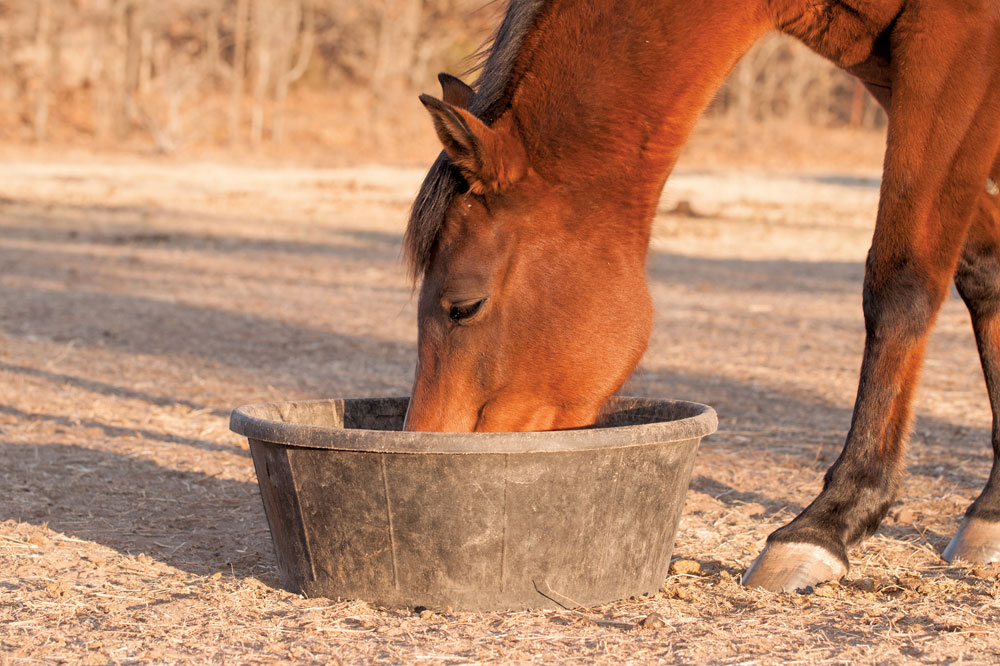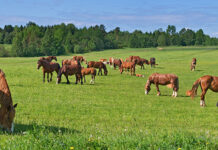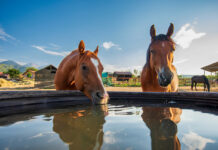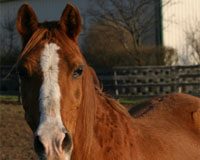When Laura arrived at the barn bearing hot bran mashes, the horses started nickering and smacking their lips. All of them, that is, except her Morgan gelding Justin.
Feeding bran mashes is an equestrian tradition that has been passed down through multiple generations. Horse owners believe they are doing something positive for their horses when they feed them bran mashes. Offering hot mashes laced with carrots, molasses or other sweets gives horse owners a particularly warm fuzzy feeling in winter. Some people can be quite dogmatic about the proper way to mix and “cook” a mash, and recipes abound to provide our equine companions with a gastronomic variety.
Evaluating the tradition of mashes in the wisdom of modern nutritional knowledge, however, may offer an explanation of why Justin turned up his nose at Laura’s lovingly prepared equine cuisine.

Why We Feed Bran
Many ingredients have found their way into livestock diets because manufacturers were searching for a profitable use for the byproducts of the milling process. In the case of bran, the process was milling wheat and the byproduct was the large reddish-brown flakes of the grain’s outer husk, which were removed before grinding the soft, inner kernel into flour.
Horses, people discovered, liked the taste of bran. And millers were more than delighted to sell bran cheaply to local farmers who fed it to their horses. There was only one problem with this turn-of-the-century feeding practice. Horses fed large amounts of bran over long periods of time developed a serious skeletal problem known as “big head.”
Bran has an extremely lopsided calcium-to-phosphorous ratio of 1-to-12. The ideal ratio of calcium to phosphorous in a horse’s diet is 1-to-1 or 1-to-2. With the ratio so badly out of balance, horses fed large quantities of bran stole calcium from their bones to achieve the right metabolic balance between the two minerals. Soft connective tissue replaced bone and created the enlarged, lumpish skulls that gave the nutritional disease its name.
Modern nutritionists eventually unlocked the secrets about mineral interactions and explained the cause of big head. Now, however, nutritional science is questioning the practice of occasional mashes for reasons that have nothing to do with mineral imbalances. Like those farmers who inadvertently overfed bran and caused big-head disease, modern horsemen may unknowingly be causing their horses distress when they feed bran sporadically as a weekly mash or as a constipation preventative just prior to traveling.
Not a Change for the Better
It is well known among veterinarians, nutritionists and experienced equestrians that a sudden change in diet causes digestive disorders in horses. At the least, the horse may experience mild intestinal discomfort that makes him cranky, anxious or sluggish. Diarrhea, excess gas, colic or laminitis are other possible consequences.
Sudden means that the change is made all at once, rather than gradually in small stages. A change in feed can be anything from switching to a new load of hay, substituting a different grain mix for one you’ve been feeding or turning a horse wintered on hay out on a lush spring pasture.
When a new feed or any other dietary change is gradually made over a period of days or even weeks, the horse’s various gut microbes, which are essential for good digestion, vitamin synthesis and overall health, have time to adjust the size of their respective populations to the shifting ratios of carbohydrates, fats, protein and fiber they must process. But when a sudden change is made, it shocks the microbe population, destroys its balance and results in the death of a proportion of these beneficial and essential microorganisms. The dying microbes are not only unable to assist in proper digestion, but they also give off toxins that can be absorbed through the intestinal walls and into the horse’s bloodstream to the detriment of the animal’s well being.
If the sudden change is a relatively small one, the horse may experience abdominal distress and discomfort, such as mild gas or diarrhea, but not life-threatening consequences, such as colic or laminitis. Researchers now suspect that is what happens when horses get a weekly or occasional bran mash. Justin may be smart enough to have connected a queasy feeling in his hind gut with the bran mash he ate just before it started. Or perhaps his gut is more sensitive to changes than those of his barn buddies. Either way, he was trying to send Laura a message.
All Brans Are Not Created Equal
Rice bran is one of the newer feedstuffs to be marketed as an equine supplement and to find its way into commercial grain mixes. Like wheat bran, rice bran is the flaked outer coating of a grain.
Rice bran is high in fiber, protein and calories. Also like wheat bran, rice bran has a significantly lopsided calcium-to-phosphorous ratio. Unlike wheat bran, however, a higher percentage of rice bran’s calories come from fats rather than carbohydrates. And that makes a big difference in how it fits into equine rations.
Rice bran contains 20 percent fat, a higher fat level than any other feedstuff commonly fed to horses, except animal or vegetable fats. A pound of rice bran contains 3.5 ounces of fat, nearly the same amount as a ½ cup of vegetable oil. That fat content also makes it a denser, heavier feed than fluffy, high-volume wheat bran. Rice bran is a coarse, buff-colored powder, while wheat bran is composed of large, flat, reddish or blonde flakes.
The combination of high fat and high fiber makes rice bran an ideal addition to the diet of hardworking performance horses. The fat provides extra energy without the hyperactivity and the risk of gastrointestinal ailments that are a risk when feeding high-starch grain diets.
Fats are metabolically efficient energy sources because they produce lower internal temperatures from digestion than carbohydrate-rich grains, and horses can easily convert the fat they digest into energy. When it comes to adding water, however, rice bran turns more to mush than mash. Because of its higher fat content and small particle size, rice bran does not absorb water like wheat bran.
If your purpose in feeding mashes has been to get more water into your horse’s digestive tract, wheat bran is more suitable.
Why Do We Do It?
If occasional bran mashes are not good for horses, why do horse owners feed them? Many firmly held beliefs about mashes are based on nothing more scientific than old horsemen’s observations as they guessed at causes and effects. Although nutritional common sense now debunks the mythology, horse owners still share it as gospel and are loathe to let go of the wisdom of ages. The reasons they give for feeding mashes include:
Myth 1. A hot bran mash warms a horse in winter. How long are you trying to warm the horse? The warming effects of the water used to make the mash may last five to 10 minutes after the horse eats it, less time that it probably took you to make the mash. A better way to warm a horse in the winter is to increase the amount of hay he eats. The heat of digestion from just 5 pounds of extra hay will raise the horse’s internal core temperature 1.2 degrees Fahrenheit for nearly four hours.
Myth 2. A bran mash is a good way to get more water into a horse in the winter. How much bran are you feeding? A typical mash only uses about a quart or two of water, more or less depending on how soupy you decide to make it. Compared to the 5 gallons or more of water the horse needs daily, that’s not a big deal.
A better way to get more water into the horse in the winter is to make sure water buckets stay thawed and water is accessible. Finding a way to warm the water to approximately 40 degrees Fahrenheit in winter will keep horses drinking sufficient amounts and make the small amount in that mash insignificant. In summer, keep water palatable and free of algae or other contaminants by changing water frequently and scrubbing buckets and troughs regularly.
Myth 3. A bran mash is a good laxative to give a horse before a long trailer ride to prevent constipation. What do you mean by a laxative? By definition, a laxative is something that increases the water content of feces. Cornell University researchers studied the laxative effect of bran at various levels in the diet, with some horses being fed up to 50 percent hay and 50 percent bran. They found that there were only slight variations in water content of feces at various feeding levels, not enough to pronounce bran a laxative.
Another study compared the stools of horses fed a ration of 10 percent bran and 90 percent chopped hay to those fed 100 percent chopped hay. No difference in the water content of the feces was found. So why do horses produce watery stool when they eat a bran mash? First, high-fiber bran increases the volume of the horse’s feces. Second, since feeding bran mash only occasionally or even weekly represents a sudden change in diet as the gut microbes see it, they start to die off. That causes the diarrhea or watery stool that horse owners erroneously assume is a laxative effect.
If you are convinced bran is a must in the diet of a traveling horse or a mare about to foal, a better way to incorporate it into their rations is to gradually add a little bran to the horse’s regular rations 10 to 14 days before the event, and keep it at a constant level. Make sure the traveling horse drinks plenty of water on the journey by getting him accustomed to drinking water flavored with a hard peppermint candy or lemon drop, a powdered drink mix, a cola drink or any other tempting taste at home. As the water changes taste from place to place on the journey, adding the familiar flavoring can help keep the horse drinking sufficient water to help avoid constipation.
What Good Is Bran?
Since horses like the taste so much, bran can encourage picky eaters to clean up their feed. Bran can be fed in amounts up to 5 to 7 percent of the horse’s total daily ration without causing harm. Balance out bran’s phosphorous content by feeding it with alfalfa or other legume hays or, if feeding grass hay, by adding 2 ounces of feed-grade limestone to the horse’s daily grain ration. Dry bran tends to be fluffy, and horses blow it around with their noses. Although it is perfectly fine to feed dry bran, moistening it keeps it from irritating the horse’s respiratory tract.
Bran’s biggest claim to fame is its high fiber content. Bran’s fiber is mostly indigestible cell-wall lignin, cellulose and hemicellulose. These undigested bits are what bulk up the feces when bran is fed on a regular basis. The key word is regular. For example, if your horse eats 20 pounds of feed daily and you have decided to make bran 5 percent of his total ration, gradually add a quarter-pound of bran every three or four days until your horse is eating a pound of bran daily. Feeding bran as a regular portion of the horse’s daily diet, rather than just as an occasional mash, will keep your horse’s gut microbes happy and forestall constipation without causing diarrhea. On a program like this, Justin may be able to face his feed once again with gusto.
– Bonnie Kreitler and Ginger Rich, Ph.D.






Bran being fed once a week to keep a horse “regular” is the biggest myth. In people fiber is something that keeps us regular but our diet is not nearly filled with the precent of fiber a horse needs and gets. If it was the metamucil company would be out of business. In horses the percentage of fiber in hay way outnumbers the percent in bran. The biggest cause of the horse having loose stool is the once a week bran that causes a mild digestive upset. When thinking of a lot of feeding myths you have to put the chemical and mineral quantities and qualities in place of common know how that has been around for centuries.
Thanks for reading- Asaka, equine science degree earner
interesting…
Your article was not only very interesting and enlightening, but it also made me realize the necessity of exposing even more horse owners to the points that you brought up. About a year ago, my boarding stable began feeding a weekly bran mash after one of the owner’s horses came down with colic. Their goal in this was to PREVENT a future episode (luckily, they have since stopped feeding the bran). At that time, I did not think anything of it, but now their actions seem entirely counterintuitive. The sad fact is that, as I now realize, the stable could’ve actually been encouraging additional colic cases without meaning to. This underscores the necessity of debunking bran myths and making sure that the information is widely known and accessible to other uninformed horsemen and women.
At my barn, it was decided by one of the horse owners that bran mash should be given every night to prevent colic. My horse started having diarrhea and now shows signs of founder. I thought the bran mash idea wasn’t a good one. I’m glad that I found this article. I’m going to make the other horse owners aware that bran mash isn’t necessary nor does it prevent colic. It seems some horse owners think they know everything and try and impart their not so intelligent wisdom on others, and the poor horses have to suffer.
Wow, that is very interesting. I had no idea about the dangers of feeding a bran mash before. I am glad i read this article before feeding my horse a bran mash.
I have fed a small bran mash once a week for many years. I began doing so after I had a horse with sand colic requiring surgery. When she came home the vet suggested I feed her a mash once a week for the rest of her life to help to remove any sand she may ingest. I have done this for all of my horses ever since. I have never had it cause loose stools and have very rarely had any colic at all. The horses do seem to enjoy it and it does make me feel good to give them a warm meal in the cold weather. I do also increase their hay when it is very cold out as well. I have heard elsewhere recently that the new school of thought is against bran mashes once a week due to the drastic change and I can understand that. I think I may switch mine over to a small amount daily. Thanks for the info.
I’ve never fed any of my horses brand mash because of the very reason that we never drastically change their feed. When switching to a new feed, we introduce it gradually, so it never made any sense to me to completely and suddenly change a horse’s meal to a bran mash. This article does a great job of describing the physiology of the bran mash on the horse’s body. If I want to warm their feed because it’s very cold, I put hot water in their grain and let it get mushy.
So, I thought about giving my horses bran mash because its a nice little treat and I thought it would warm them up a bit. After reading this though, it doesn’t sound like such a good idea anymore. I have been putting hot water in the grain so it can soften and they seem to like it just fine so I guess I will stick with that. Also, does putting hot water in the grain cause it to loose any of the nutrients? And how much extra calories does a bran mash have because I have a very easy keeper that I can’t afford to let her gain any weight.
I would like to know, if feeding a bran mash is not good for the horse, then why does the vet tell me to feed a bran mash after a horse has colic?
I have been feeding my gelding a bran mash daily for the past 7 years. Now I have heard it can harm him rather than help… I would like to say he gets 1 1/2 sm scoups everynight with water and he has never colic Is it best to take him off it? this article has confused me? do you or don’t you feed bran????
Elizabeth, Hot water does cause food to lose nutrients, HOWEVER, if the water is left in it, and they eat the water with it, they will get the nutrients anyway, so I don’t think you should worry about that.
If you feel strongly about adding hot water to your horse’s feed then restrict yourself to warm only. Hot water destroys the viability of vitamins, which is why you should steam your own veg and not keep them in hot water for long or all the goodness is removed
I started feeding bran mash in the 70’s. Not sure how everyone does it, but I add cooked barley (I use oil and Molasses to barley as it is cooking). It is VERY important that calcium and potassium is added and that bran is dry crumbly not wet a gushy and mixed at every feeding not left mixed as it will get too wet. There are no recalls on this and keeps horse very level headed.
Great article.
We live in The Sonoran Desert and our horses intake alot of sand. Does not “Bran” assist in the digestive process ?
Where can I find the study of Cornell University?
I have fed bran mash to my horses for forever. I grew up overseas and didn’t have access to processed feeds and I don’t like a lot of the additive stuff in processed feed.
Our horses lived well into their 30’s. I have a rescued OTTB (I’ve had him for 14 years) who just turned 27.
I boil barley, add omega oil and some molasses (maybe 2 tbs to 5 qts of cooked barley). I make sure the mixture is a dry crumbly as to not interfere with stomach. I add supplements as well.
Their coats are shiny and they aren’t “hot”, very level headed.
I used to use wheat bran and have now switched to rice bran for the added fat.